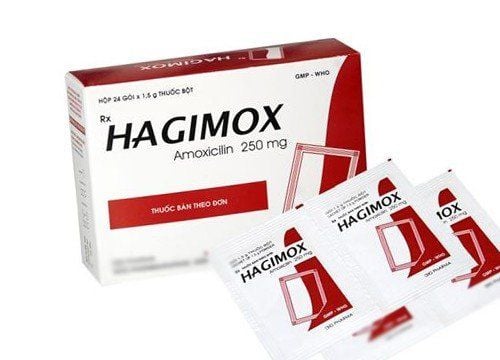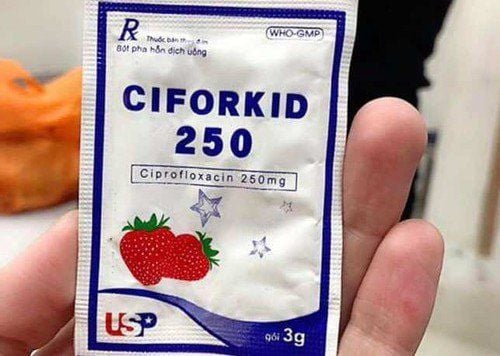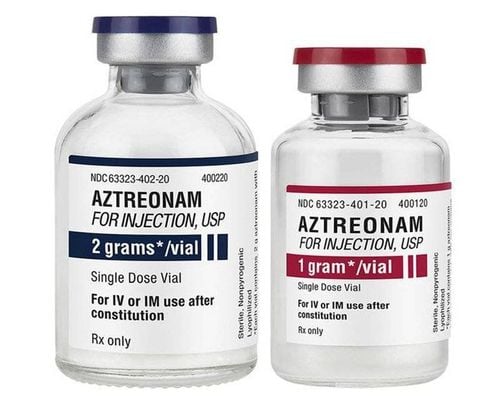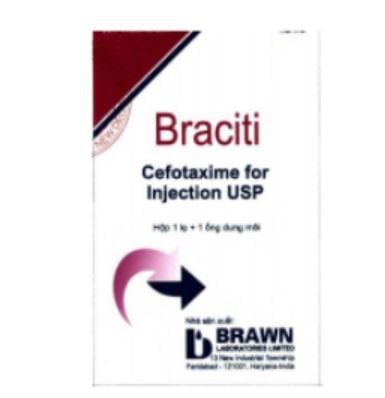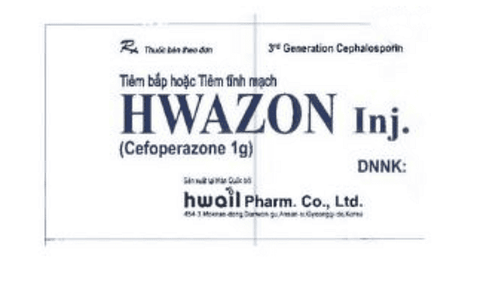This is an automatically translated article.
Greadim is an antibiotic that is given by injection. Greadim is indicated in cases of infections caused by bacteria sensitive to this antibiotic. Let's find out information about the uses, ingredients and notes when using the drug through the article below.
1. What is Greadim?
The drug Greadim has the main ingredient is the antibiotic Ceftazidime anhydrous. Prepared in sterile powder form for injection or infusion with a concentration of ceftazidime 1g or ceftazidime 2g. Ceftazidime is a 3rd generation cephalosporin antibiotic with bactericidal effect by inhibiting bacterial cell wall synthesis enzymes. The drug is stable against most beta-lactamase-producing bacteria, except Bacteroides. The drug is a broad-spectrum antibiotic, sensitive to many gram-negative bacteria that are resistant to aminoglycosides and gram-positive bacteria that are resistant to ampicillin and other cephalosporins.
Antibacterial spectrum: Ceftazidime works well on aerobic Gram-negative bacteria including: Pseudomonas (P.aeruginosa), E.coli, Proteus, Klebsiella, Enterobacter, Acinetobacter, Citrobacter, Serratia, Salmonella, Shigella, Haemophilus influenzae, Neisseria gonorrhoea and Neisseria meningitidis. Certain strains of Pneumococcus, Moraxella catarrhalis, and beta-hemolytic Streptococcus and Streptococcus viridans. Many anaerobic Gram-positive strains are also susceptible to this antibiotic, Staphylococcus aureus is moderately sensitive to Ceftazidime.
Note when choosing antibiotics: Ceftazidim has no effect on methicillin-resistant Staphylococcus aureus, Enterococcus, Listeria monocytogenes, Bacteroides fragilis, Clostridium difficile, Campylobacter spp.,
2. Indications and contraindications of the drug Greadim
2.1. Indications Ceftazidim antibiotic is only used in very severe infections, which have not been helped by conventional oral antibiotics to limit drug resistance.
Indicated in cases of severe bacterial infections such as:
Septicemia Meningitis. Complicated urinary tract infections. Lower respiratory tract infections, bacterial infections in viscous mucus disease. Bone and joint infections. Severe gynecological infections. Intra-abdominal infection. Skin and soft tissue infections, including burn and wound infections. If the above infections are confirmed or suspected to be caused by P.seudomonas or Staphylococcus as in Pseudomonas meningitis, infections in people with neutropenia, Ceftazidime should be combined with other antibiotics. .
2.2 Contraindications Patients with a history of hypersensitivity to any component of the drug Greadim. Do not use if you are allergic to other antibiotics in the Cephalosporin group.
3. Dosage and how to use Greadim
3.1 How to use Greadim Ceftazidim is administered by deep intramuscular injection, slow intravenous injection over 3-5 minutes, or by intravenous infusion.
Solution for intramuscular injection: Dilute the drug in distilled water for injection, or with 0.5% or 1% lidocaine hydrochloride injection solution, with a drug concentration of about 250 mg/ml. Intravenous solution: Dilute Ceftazidim in distilled water for injection, 0.9% sodium chloride solution, or 5% dextrose, with a concentration of about 100mg/ml. Solution for infusion: Mix the drug in the same solutions as in intravenous injection but with a lower concentration of 10-20 mg/ml (1-2g of drug in 100ml of solution). Notes on drug use:
If mixed with sodium bicarbonate solution: Reduce drug effect. Do not mix ceftazidime in a solution with a pH above 7.5 and do not mix it in a solution of sodium bicarbonate). Combination with antibiotic vancomycin must be used separately, because it causes precipitation. Do not mix ceftazidime with aminoglycoside antibiotics (gentamicin, streptomycin), or metronidazole antibiotics. The catheters and syringes must be carefully rinsed with physiological saline between administrations of two different drugs, to avoid precipitation. 3.2 Dosage of Greadim Adults:
The average dose is lg deep intramuscularly or intravenously every 8-12 hours. The dose is increased to 2g within 8 hours in Gram-negative meningitis and immunocompromised diseases. Urinary tract infections: 500mg every 12 hours. Elderly people over 70 years old: The 24-hour dose should be reduced to 50% of the normal dose, up to 3g/day.
Children and children:
Children over 2 months old, the usual dose is 30 to 100 mg/kg/day in 2-3 divided doses, (8 or 12 hours apart). The dose may be increased to 150 mg/kg/day (up to a maximum of 6 g/day) in 3 divided doses for very severe diseases. Infants and children under 2 months of age: the usual dose is 25-60 mg/kg/day, which can be divided into 2 doses, 12 hours apart. In the case of meningitis in infants older than 8 days, the usual dose of 50 mg/kg every 12 hours can be used. Patients with impaired renal function should be based on creatinine clearance: When less than 50 mg/min, the dose should be reduced. For patients with suspected renal insufficiency, the first dose, usually 1 g, can be given, followed by altering the maintenance dose depending on creatinine clearance as follows:
Creatinine clearance 50 - 31 ml/min: Administer 1 g every other day. Once every 12 hours. Creatinine clearance 30-16 ml/min: Administer 1g every 24 hours. Creatinine clearance 15 - 6 ml/min: 0.5g every 24 hours. Creatinine clearance less than 5 ml/min: 0.5g every 48 hours. Patients on hemodialysis can add 1g at the end of each dialysis session.
Note: When taking Ceftazidime, it is necessary to use it for at least 2 days after the symptoms of infection are gone, but it may take longer when the infection is complicated.
3.3 Overdose of Greadim Drug overdose has been reported in some patients with renal failure. Overdose reactions include convulsions, encephalopathy, tremors, excitability. Patients with acute overdose should be carefully monitored and supportive treatment instituted. In renal failure, the patient may need hemodialysis or peritoneal dialysis for rapid drug elimination.
4. Side effects of the drug Greadim
When using Greadim, it was found that at least 5% of patients treated had undesirable effects, including:
Common:
Local: Irritation at injection site, thrombophlebitis. Skin: Itching, maculopapular rash, exanthema. Uncommon:
Body as a whole: Headache, dizziness, fever, Quincke vin edema, anaphylactic reaction. Blood: Eosinophilia, thrombocytopenia, leukopenia and neutropenia, lymphocytosis, positive Coombs reaction. Nervous: Sensory disturbance and dysgeusia; In patients with renal failure, improper treatment may cause convulsions, encephalopathy, tremor, and neuromuscular excitability due to overdose. Gastrointestinal: Nausea, vomiting, abdominal pain, diarrhea. During the course of taking the drug, if any unusual symptoms occur, you should notify your doctor or nurse immediately. Especially abnormalities that occur during and immediately after injection such as difficulty breathing, severe abdominal pain... need to be reported immediately.
5. Notes when using Greadim
Before starting treatment with the antibiotic Ceftazidim, the patient's history of allergy to cephalosporins, penicillins or other drugs should be thoroughly investigated. Cross-reactivity between penicillins and cephalosporins may occur.
Although Greadim is not nephrotoxic, caution should be exercised when co-administered with nephrotoxic drugs.
During drug administration, resistance to some strains of Enterobacter may occur. The risk of drug resistance should be taken into account so that other drug combinations can be appropriate.
Ceftazidime may decrease prothrombin time. Prothrombin time should be carefully monitored in patients with renal, hepatic, or malnourished patients and, if necessary, vitamin K should be added.
Caution should be taken when administering Ceftazidim to people with a history of gastrointestinal disease, especially dysentery.
Pregnancy: Cephalosporins are considered safe during pregnancy. However, there are currently no adequate and well-controlled studies in pregnant women, so this drug should be used during pregnancy only when clearly needed.
Lactation period: The drug is excreted in milk, the effect of the drug may cause on nursing infants, so it must be considered when using the drug for those who are breastfeeding.
Interactions with other drugs: Greadim may cause interactions with aminoglycosides or potent diuretics such as furosemide. Chloramphenicol is antagonized in vitro with Ceftazidime and should be avoided when bactericidal action is required.
Above is information about the drug Greadim, this is a prescription drug and should be used with extreme caution. Use only when other antibiotics are ineffective or less sensitive.
Please dial HOTLINE for more information or register for an appointment HERE. Download MyVinmec app to make appointments faster and to manage your bookings easily.




